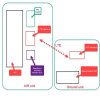Hey guys - I know there are a few posts on LTE possibilities, but I have a concept for a velcro-on LTE interface that would work with virtually all Mavic models and doesn't require any mods to the actual drone.
Curious if you guys have any thoughts on why this wouldn't work:
The design would be to have a Rasberry Pi Zero W (with wifi) computer with add-on LTE modem running android strapped onto the actual drone. Running on the Rasberry Pi Zero would be a small android app that consumes the DJI Android SDK. The app would be listening on the internet via the LTE connection and sending virtual stick commands to the WIFI of the drone (which is only 1 inch away because the whole thing is strapped to the drone).
For those Mavic drones (Mavic mini) that don't support direct Wifi communication, it might be possible to rip out part of the Mavic Mini controller that handles the USB interface between the device and the controller and bolt this on.
To control it, you have a simple iOS or Android app that presents virtual sticks and a FPV and communicates via LTE to the Rasberry Pi strapped to the drone.
All of this stuff together should be pretty lightweight and easy for all Mavic drones to lift (even the Mavic Mini)
LMK what you think
Curious if you guys have any thoughts on why this wouldn't work:
The design would be to have a Rasberry Pi Zero W (with wifi) computer with add-on LTE modem running android strapped onto the actual drone. Running on the Rasberry Pi Zero would be a small android app that consumes the DJI Android SDK. The app would be listening on the internet via the LTE connection and sending virtual stick commands to the WIFI of the drone (which is only 1 inch away because the whole thing is strapped to the drone).
For those Mavic drones (Mavic mini) that don't support direct Wifi communication, it might be possible to rip out part of the Mavic Mini controller that handles the USB interface between the device and the controller and bolt this on.
To control it, you have a simple iOS or Android app that presents virtual sticks and a FPV and communicates via LTE to the Rasberry Pi strapped to the drone.
All of this stuff together should be pretty lightweight and easy for all Mavic drones to lift (even the Mavic Mini)
LMK what you think










